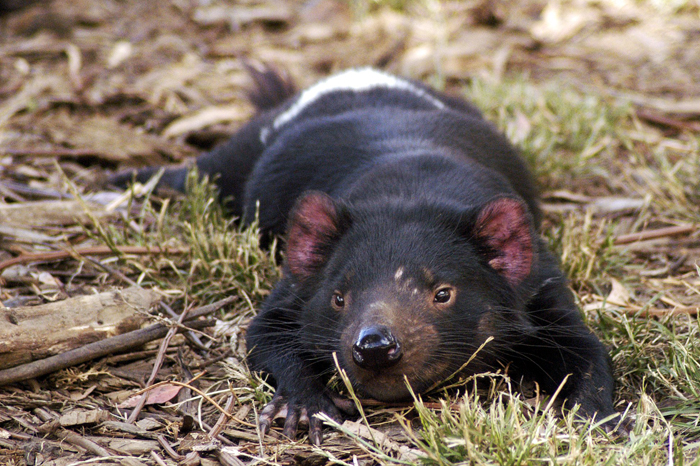WSU researchers investigate contagious cancer in Tasmanian devils
A Tasmanian devil relaxes at Tasmanian Devil Conservation Park in Taranna, Tasmania, Friday, Jan. 3, 2003
December 3, 2013
A contagious cancer is threatening the entire Tasmanian devil species.
WSU received a $2.25 million National Science Foundation grant at the beginning of the school year to study the disease, which is rapidly killing off the population.
The marsupials, found only in Australia, have seen a decline of about 70 percent since Devil Facial Tumor Disease was discovered in 1996. Tasmanian devils that bite an infected animal usually develop facial tumors of their own a few months later and live for about two years instead of five.
WSU biological sciences professor Andrew Storfer is the lead researcher for the project. He and his colleagues are examining genetic material in tissue samples from the marsupials.
The project also involves sensors that are activated when two individuals are near each other, such as when the scavengers fight over carrion. Storfer said this is to map out a “contact network.”
“You and all your friends on Twitter or Facebook, depending on how frequently you tweet or how many friends you have, that determines your degree of centrality in a network,” he said. “By the same token, you can look at…these social interactions (of Tasmanian devils) and see who has the most contacts and who might be most important for disease transmission.”
The researchers plan to combine this information with what they learn from genetic sequencing to determine how the disease will emerge and spread in uninfected populations.
“And that’s something that’s never really been done in a wildlife population before, so our hope is we can do something really new,” Storfer said.
The project also involves researchers in Australia at the Wellcome Trust Sanger Institute in England and at the University of Idaho.
Paul Hohenlohe, a U of I assistant biology professor, is studying the Tasmanian devil genome with Storfer.
“In some populations, the disease wiped out 95 percent of the animals,” Hohenlohe said. “The question is: is there anything about the 5 percent remaining that’s genetically different from the 95 percent that got killed off?”
While the researchers have little hope of stopping the disease, in the future breeders of captive Tasmanian devils may be able to use the information gleaned to keep the species from going extinct.
The disease is one of only two known contagious cancers. The other infects dogs. However, the researchers hope to gain some insight into cancers affecting people, and particularly recurring tumors.
Tasmanian devils’ immune systems share some similarities with human immune systems, but there are no infectious cancers in humans. Viruses such as HPV can lead to cancer, but Devil Facial Tumor Disease is not viral.
Hohenlohe said the contagious tumors give the researchers a broader view of how cancers evolve.
“Cancer itself is an evolutionary process,” Hohenlohe said. “So if a person gets cancer, it’s not just a static thing. It’s a population of cells that are evolving and changing genetically, changing rapidly.”
But this cancer behaves differently from traditional cancers.
“When the person dies or the tumor is removed, that evolutionary process stops. But in this case, the evolutionary process is continuing as the tumor cells are transferred from one devil to another,” Hohenlohe said.
Storfer said they will also gain knowledge of the evolution of organisms and the pathogens that affect them, the “evolutionary arms race” that for humans can be seen in antibiotic resistance as bacteria adapts and becomes stronger than what humans fight them with.





















